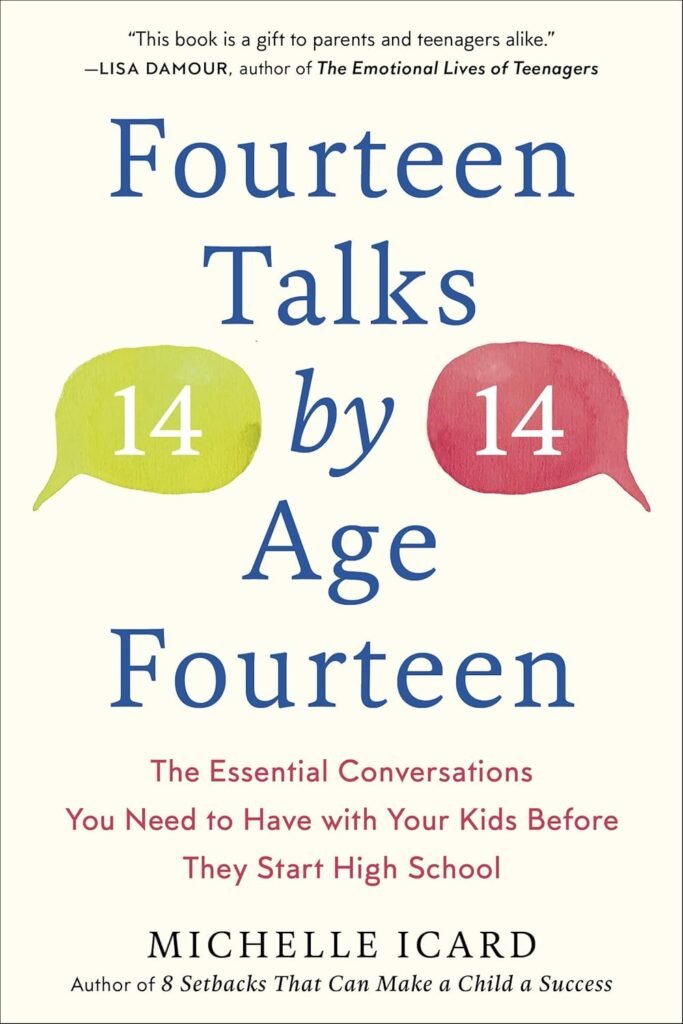[aiwm-amazon-card title=”Fourteen Talks by Age Fourteen: The Essential Conversations You Need to Have with Your Kids Before They Start High School Paperback – September 5, 2023″ image_url=”https://m.media-amazon.com/images/I/71dSOi1wsiL._SL1500_.jpg” product_url=”https://www.amazon.com/dp/0593137523?tag=ledlightin05e-20″ original_price=”17.99″ discounted_price=”11.99″ currency=”USD|$” availability=”In Stock” disclaimer=”As an Amazon Associate, I earn from qualifying purchases”]
Why Is Parenting So Much Like Herding Cats?
Let’s face it, parenting teenagers is a bit like trying to nail jelly to a wall. Just when you think you’ve figured it out, they shape-shift into new beings with entirely unforeseen existential crises. “Fourteen Talks by Age Fourteen” is the roadmap we all need when it feels like the GPS of life has totally failed us. It’s like a survival guide for the delicate social jungle that is high school, and you’re Mowgli but with less enthusiasm for swinging from vines—and more strategizing about how to get them to talk to you without rolling their eyes.
The Book’s Purpose: To Parent or Not to Parent – That Is the Question
Imagine having a teenager who volunteers details about their day without being bribed with their favorite ice cream. (Go ahead, take a moment; we know it’s hard.) Lisa Damour, the wise owl flapping through this book, nudges you toward achieving closer connections with your teen without sounding like a clichéd sitcom parent. It’s about opening channels of communication that go beyond the usual grunts and mumbles. Think of it as unlocking hidden levels in a video game where the boss fight isn’t your kid’s sass, but their life’s challenges.
Author’s Background: Raising the Whisperer’s Level of Expertise
Picture a child psychologist who possesses a Sherlockian sense of deduction when it comes to adolescent brains. That’s Lisa Damour. With a résumé that includes writing for The New York Times and providing guidance on talking to teens in a way that doesn’t make them eye-roll induced comas, Damour is your weekend escape from ‘Why do you never listen to me?’ island. She comes armed with research-based tips and anecdotes that remind you, blissfully, that it’s not just you, it’s a universal parental conundrum.
This image is property of Amazon.com.
Why Fourteen? The Unlikely Hero of Age Numbers
Of all the ages, why does fourteen get its own book? Simple. Fourteen is like the year-long equivalent of saying “hold my beer.” It’s a numinous crossroads where enthusiasm slowly gives way to awareness. They’ve graduated from the joyous oblivion of Tweendom, and each pulse of their hormone-packed vocals should come with a health warning. It’s here that the tectonic plates of childhood start their subtle yet grand shift toward adulthood. They begin to ask questions that exceed the emotional depth of a puddle in summer, thus providing mastery in engaging with them could mean treading on solid ground when negotiations for curfews begin.
| Conversation Number | Topic | Why It Matters |
|---|---|---|
| 1 | Friendship | Your child will start deciding what defines their social circles. In other words, you can stop being their only friend. |
| 2 | Managing Emotions | This one’s close to tricking emotions into napping – which is a necessity post chocolate shortage. |
| 3 | Chores and Responsibilities | Because asking them to bring their laundry down shouldn’t require intensive negotiations. |
| 4 | Technology | As in, how to use technology without turning into Gollum from “The Lord of the Rings.” My precious… WiFi. |
| 5 | Protecting Their Inner World | Encouraging your child to understand that maintaining a moral compass is not just for superheroes saves the day. |
Friendship: Finding Their Merry Band of Musketeers
Whether they’re joining the Mathletes or the band, friend groups in high school shape their prosperous, or at least functionally productive, high school years. Damour decoratively weaves how these friendships can be sources of support or drama (you’ve been in a lunchroom, right?). As an adult, you learn how to guide them through what constitutes a healthy relationship, unless they start regaling stories about inevitable betrayal that echo Shakespeare.
This image is property of Amazon.com.
Managing Emotions: A Symphony of Teenage Angst
Imagine James Brown yelling loudly about feeling good, now think of that in reverse for teenagers experiencing emotions. It’s disjunctive and often unexpected. This section addresses how their outbursts could rival a daytime TV melodrama scene. Damour advises embracing their inner Mahler symphony, allowing them to process and name the feelings they’re having. Helpful tip—buy stock in tissues along the journey.
Chores and Responsibilities: Dodging the Lava of Socks
Chores aren’t just about cleaning up after themselves so much as learning how to exist in a world without “disappearing gum stuck to the bottom of a shoe” surprises. Damour’s emphasis on fostering independence through chores will leave you sighing with relief and maybe, maybe, about having that one argument where slamming doors doesn’t happen as you divide the household responsibility pie. True culinary art.
This image is property of images.pexels.com.
Technology: The Joy of Discovering LOL Doesn’t Mean Lots of Love
Talking technology is no simple feat, particularly when their entire social existence is wrapped around making sure the Snapchat streak continues unabated. Damour guides you through digital navigation avoiding pitfall topics like explaining why TikTok dances aren’t real currency and why oversharing isn’t advisable. It’s the thin line between acceptance of tech as survival and worried scrutiny.
Protecting Their Inner World: Because Their World is Scary Enough
Teen brains are akin to abstract art – colorful, baffling, and open to unique interpretation. Damour’s narrative urges parents to help their children forge reflective practices so that moral codes aren’t just tattooed because they think it looks edgy. The idea is to sink an anchor in the sea of uncertainty that is high school maisha (that’s Swahili for life, folks).
This image is property of images.pexels.com.
Overall Review Covering the Ground of Mom-Dad Land
The tome stands as a lighthouse steering you away from the treacherous reefs of teenage years. Damour manages to keep the book simultaneously conversational and deeply insightful, sliding gracefully through each of the fourteen must-have conversations with nuggets of wisdom that can charm an eye roll into a meaningful pause. If this book were a person, it would probably be David Attenborough, delightfully educating while staying endlessly composed.
Refining the Art of Conversation: Because “How Was School?” Won’t Cut It
In embarking on this fourteen-chapter ride, you find that Tiny Tims aren’t so much “Bah Humbug” versions of themselves, but instead, amusing potions concocted by slapping the good, the bad, and the ugly of puberty together. Damour practically hands you a mystery solving kit for unraveling the world from their perspective. And if they’re storming off that doesn’t mean you’re losing, it just means you’re making progress.
So buckle up, grab that coffee annnnnd…oh wait, did you hear the faint yell demanding grilled cheese? Alas, the dance resumes.
Discover the latest books on parenting teenagers as well as tips and tricks on how to cope with your teen while keeping your mental health intact.
Disclosure: As an Amazon Associate, I earn from qualifying purchases.











0 responses to “Fourteen Talks by Age Fourteen Review”